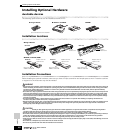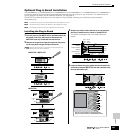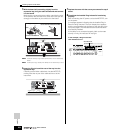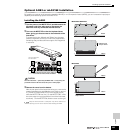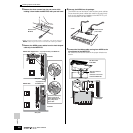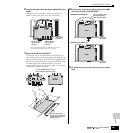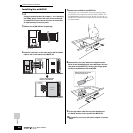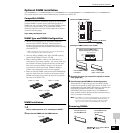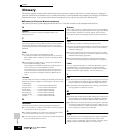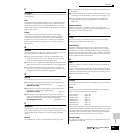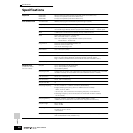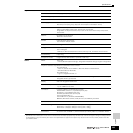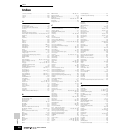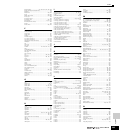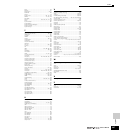
Appendix
Glossary
290
Owner’s Manual
Glossary
This section explains in detail various words and terms that were not covered in the manual. Another resource for looking up
unfamiliar technical terms related to music, synthesis and audio is a special website we’ve prepared, the Glossary for Electronic
Musical Instruments. If you come across a musical or technical term you don’t know, click on the following URL.
■ Glossary for Electronic Musical Instruments
http://www2.yamaha.co.jp/manual/english/word/index.html (This URL and title may be changed without notice.)
A
Audition
The function or process of hearing the edited sample (in the
Sampling function).
C
Channel
There are two types of channels: MIDI channels, which are used to
transmit MIDI messages, and audio channels, which are used to
send audio signals. You can set the MIDI channel in the display of the
MOTIF ES.
Clock
[1] A unit of note resolution for MIDI Sequence data.
The sequencer determines the playback position of the Song or
Pattern (MIDI sequence data) by using the units Measure, Beat,
and Clock.
[2] Also referred to as “MIDI Clock” or “Timing Clock” defined as
System Realtime Message in MIDI.
This message is transmitted at a fixed interval (24 times per 1/4
note) to synchronize connected MIDI instruments.
On the MOTIF ES, the Utility mode lets you select whether the
instrument’s internal clock will be used as the Timing Clock, or
external Timing Clock messages received via MIDI IN will be
used.
Common
This edit related term refers to the editing of parameters that affect all
Elements or Parts of a program. For each program, this term is used
as listed below.
• Normal Voice.................Common Edit and Element Edit
• Plug-in Voice .................Common Edit and Element Edit
• Drum Voice....................Common Edit and Key Edit
• Performance .................Common Edit and Part Edit
• Song Mixing ..................Common Edit and Part Edit
• Pattern Mixing ..............Common Edit and Part Edit
• Master ...........................Common Edit and Zone Edit
D
Destination
The MOTIF ES provides the following three types of destination.
[1] In copy operations, this refers to the location to which the original
“source” data or file is to be copied.
[2] In sampling operations, this refers to the internal memory area to
which the external audio “source” is to be recorded.
[3] In the Controller Set function, this refers to the parameter adjusted
by the controller defined as “Source.”
Directory
This is a path created on a data storage device (such as SmartMedia
card or hard disk), allowing a tree-like hierarchical organization of data
files and folders. Effectively a virtual file cabinet, this is the place
where files are stored and arranged according to type or application.
F
Filter
The MOTIF ES provides the following three types of Filter.
[1] A circuit or processor that modifies tone by blocking or passing a
specific frequency range of the sound. This is one of the Voice
parameters (page 161).
[2] A function (referred to as “Event View Filter”) that lets you select
the event types that appear on the Event List display in the Song
Edit/Pattern Edit display (page 225).
[3]
A function (referred to as “MIDI Filter”) that determines which MIDI
events will be transmitted/recognized via the MIDI IN/OUT (page 262).
Folder
This is an organizational feature on a data storage device (such as
SmartMedia card or hard disk), allowing you to group data files
together according to type or application. Folders can be nested in
hierarchical order for organizing data. (Also see “Directory.”)
L
LSB
[1]
An abbreviation for Least Significant Byte, referring to the lower byte of
data when MIDI control change data (such as Bank Select and Data
Entry) is divided into two bytes (the MSB and LSB) for transmission.
[2] An abbreviation for Least Significant Bit, referring to the lowest bit
among eight bits that make up one byte.
M
MSB
[1]
An abbreviation for Most Significant Byte, referring to the upper byte of
data when MIDI control change data (such as Bank Select and Data
Entry) is divided into two bytes (the MSB and LSB) for transmission.
[2] An abbreviation for Most Significant Bit, referring to the uppermost
bit among the eight bits that make up one byte. In MIDI, this “bit”
is very important because it determines whether the byte to which
this “bit” belongs is a status byte or data byte.
O
Offset
A type of editing in which a specified value (the “offset”) is added to
or subtracted from the current parameter value. Unlike normal
editing, in which the parameter is given a specific, new value, offset
editing changes the parameter relative to its current value.



